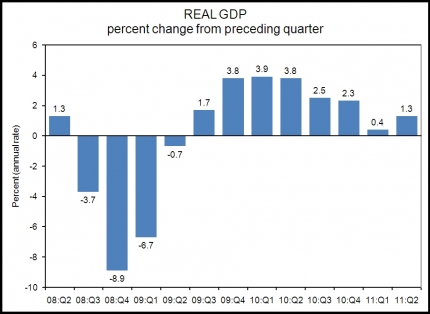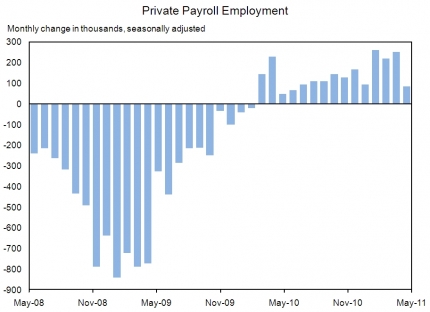Council of Economic Advisers Blog
The Employment Situation in July
Posted by on August 5, 2011 at 9:47 AM EDTToday’s employment report shows that private sector payrolls increased by 154,000 in July and the unemployment rate ticked down to 9.1 percent. The economy has added 2.4 million private sector jobs over the past 17 months, despite a slowdown in economic growth from substantial headwinds in the first half of the year.
While the better than expected report is welcome news, the unemployment rate remains unacceptably high and faster growth is needed to replace the jobs lost in the downturn. Bipartisan action is needed to help the private sector and the economy grow – such as measures to extend both the payroll tax cut and unemployment insurance, as well as passing the pending free trade agreements with re-employment assistance for displaced workers, the patent reform bill, and a bipartisan infrastructure bill to help put Americans back to work. This week we averted an economic catastrophe by avoiding a default and putting in place an important down payment on long term deficit reduction. We will continue to work with Congress to build on these efforts to achieve a broader balanced deficit reduction agreement that instills confidence and allows us to live within our means without shortchanging future growth.
Learn more about EconomyAdvance Estimate of GDP for the Second Quarter of 2011 and Annual Revision
Posted by on July 29, 2011 at 10:15 AM EDTToday’s report shows that the economy posted the eighth straight quarter of positive growth, as real GDP (the total amount of goods and services produced in the country) grew, but at only a 1.3 percent annual rate in the second quarter of this year. The downward revision in the first quarter to 0.4 percent further reflects the slowdown of economic growth due to substantial headwinds faced in the first half of this year. Additionally, the annual revision to GDP showed that the Great Recession – the worst on record – was even deeper than originally estimated.
We are at a fragile moment in the world economy and cannot afford to do anything to undermine our recovery at a moment such as this. The unemployment rate is unacceptably high and faster growth is needed to replace the jobs lost in the downturn. This report underscores the need for bipartisan action to help the private sector and the economy grow – such as measures to extend the payroll tax cut and unemployment insurance, pass the pending free trade agreements with re-employment assistance for displaced workers, and create an infrastructure bank to help put Americans back to work. It also underscores the need to end the uncertainty surrounding the risk of default and put in place a balanced approach to deficit reduction that phases in budget cuts, instills confidence, and allows us to live within our means without shortchanging future growth.
Notable contributions to real GDP growth in the second quarter included net exports (0.6 percentage points) and fixed investment (0.7 p.p.). Defense spending added 0.4 p.p. to GDP, but this gain was offset by declines in state and local government (-0.4 p.p.) and nondefense spending (-0.2 p.p.). Consumer spending rose just 0.1 percent at an annual rate, with a steep decline (23 percent) in motor vehicle consumption accounting for the weakness. The downward revision to first quarter GDP from 1.9 percent to 0.4 percent reflects lower contributions from inventory investment and imports.
In this year’s annual GDP revision, the overall downward revision was concentrated at the end of 2008 and the beginning of 2009, so that growth in 2008:Q4 was revised to -8.9 percent from -6.8 percent and 2009:Q1 was revised to -6.7 percent from -4.9 percent. What was already the deepest reported recession since official quarterly estimates began in 1947 is now reported to have been significantly worse.
Austan Goolsbee is Chairman of the Council of Economic Advisers
Learn more about EconomyMaking Our Economy Stronger: The Need for High-Skilled Immigration Reform
Posted by on July 28, 2011 at 2:09 PM EDTIt is one of the great American stories, repeated countless times over decades. An immigrant to the US, sitting in a lab or a company or even at home, working to start a company that ends up becoming a great American success story.
Some of our greatest companies began exactly this way. And immigrants today have great ideas that can change the world. The question is whether they will develop them in the United States or somewhere else. Our immigration system should be designed to encourage talented people to study in the United States and start companies here. But today, foreign students studying science and engineering at America’s top universities are actually discouraged from using the skills they learn to create American jobs and make our economy more competitive. The end result is that we end up training innovators and entrepreneurs for other countries. That makes no sense. Instead of showing these future entrepreneurs and scientists the door, we should be stapling a green card to their diplomas and providing Startup Visas to those with the best ideas.
Earlier this week, Senator Schumer hosted a Senate Subcommittee hearing on the “Economic Imperative for Enacting Immigration Reform”. A consistent theme among the hearing panelists, which included leaders from Microsoft and Nasdaq, was that reforming our high skill immigration policy is critical to creating American jobs and spurring economic growth.
Learn more about Economy, ImmigrationThe Employment Situation in June
Posted by on July 8, 2011 at 9:45 AM EDTToday’s employment report shows that private sector payrolls increased by 57,000 in June and the unemployment rate ticked up to 9.2 percent. While the private sector has added 2.2 million jobs over the past 16 months, this month’s report reflects the recent slowdown of economic growth due to headwinds faced in the first half of this year.
The unemployment rate remains unacceptably high and faster growth is needed to replace the jobs lost in the downturn. Today’s report underscores the need for bipartisan action to help the private sector and the economy grow – such as measures to extend the payroll tax cut, pass the pending free trade agreements, and create an infrastructure bank to help put Americans back to work. It also underscores the need for a balanced approach to deficit reduction that instills confidence and allows us to live within our means without shortchanging future growth.
Overall payroll employment rose by just 18,000 in June. Sectors with employment increases included leisure and hospitality (+34,000), health care (+13,500), and manufacturing (+6,000). Sectors with employment declines included government (-39,000), financial activities (-15,000), and construction (-9,000). Manufacturing has added 251,000 jobs since the beginning of 2010, the best period of manufacturing job growth in over a decade. Meanwhile, local governments lost 18,000 jobs in June and have shed 355,000 jobs since the start of 2010.
The monthly employment and unemployment numbers are volatile and employment estimates are subject to substantial revision. Therefore, as the Administration always stresses, it is important not to read too much into any one monthly report.
Austan Goolsbee is Chairman of the Council of Economic Advisers
Learn more about EconomyPromoting an Open Investment Policy to Create Jobs and Grow the Economy
Posted by on June 20, 2011 at 1:20 PM EDTToday, President Obama released a statement on the United States Commitment to Open Investment Policy. The CEA also released a report on the benefits of foreign-based companies investing in the United States (known more formally as “Inbound Foreign Direct Investment”).
Our report highlights how the Administration’s open investment policy allows foreign-based companies to grow and expand their businesses across the country. These companies are building new facilities, investing in research and development, and growing warehouses, sales offices and service centers—creating millions of high-quality, well-paying jobs for American workers. These firms paid out wages and other forms of compensation that averaged more than $71,000 per U.S. employee in 2008, as compared to average earnings of $54,000 for full-time annual workers in the economy as a whole.
The U.S. continues to receive the most foreign direct investment of any country in the world. In 2010, U.S. inbound foreign direct investment rebounded sharply and increased by 49 percent from the economic crisis level it reached in 2009. This investment is particularly important to the U.S. manufacturing sector. In 2008, the U.S. affiliates of foreign corporations employed 13 percent of the entire manufacturing workforce in the United States. And over 42 percent of the US affiliates’ total value-added production in 2008 was concentrated in the U.S. manufacturing sector.
Learn more about Economy, Foreign PolicyThe Employment Situation in May
Posted by on June 3, 2011 at 9:30 AM EDTToday’s employment report shows that private sector payrolls increased by 83,000 in May and the unemployment rate ticked up to 9.1 percent. There are always bumps on the road to recovery, but the overall trajectory of the economy has improved dramatically over the past two years.
While the private sector has added more than 2.1 million jobs over the past 15 months, the unemployment rate is unacceptably high and faster growth is needed to replace the jobs lost in the downturn. The initiatives put in place by this Administration – such as the payroll tax cut and business incentives for investment – have contributed to solid employment growth overall this year, but this report is a reminder of the challenges that remain. We are focused on promoting exports, reducing regulatory burdens and making the investments in education, research and development, and infrastructure that will grow our economy and create jobs. We will continue to work with Congress to responsibly reduce the deficit and live within our means.
Overall payroll employment rose by 54,000 in May. Solid employment increases occurred in professional and business services (+44,000) and education and health services (+34,000). Sectors with employment declines included local government (-28,000), retail trade (-8,500), and manufacturing (-5,000). Despite the decline this month, manufacturing has added 238,000 jobs since the beginning of 2010, the best period of manufacturing job growth in over a decade.
The monthly employment and unemployment numbers are volatile and employment estimates are subject to substantial revision. Therefore, as the Administration always stresses, it is important not to read too much into any one monthly report.
Austan Goolsbee is Chairman of the Council of Economic Advisers
Learn more about Economy
- &lsaquo previous
- 1
- 2
- 3
- 4
- 5
- 6
- 7
- 8
- 9
- …
- next &rsaquo
White House Blogs
- The White House Blog
- Middle Class Task Force
- Council of Economic Advisers
- Council on Environmental Quality
- Council on Women and Girls
- Office of Intergovernmental Affairs
- Office of Management and Budget
- Office of Public Engagement
- Office of Science & Tech Policy
- Office of Urban Affairs
- Open Government
- Faith and Neighborhood Partnerships
- Social Innovation and Civic Participation
- US Trade Representative
- Office National Drug Control Policy
categories
- Blueprint for an America Built to Last
- Equal Pay
- White House Internships
- Civil Rights
- Defense
- Disabilities
- Economy
- Education
- Energy and Environment
- Ethics
- Family
- Fiscal Responsibility
- Foreign Policy
- Health Care
- Homeland Security
- Immigration
- Inside the White House
- Poverty
- Rural
- Seniors and Social Security
- Service
- Taxes
- Technology
- Urban Policy
- Veterans
- Women
- Additional Issues











